by Eric Meier
When attempting to identify a wood sample, it’s important to keep in mind the limitations and obstacles that are present in our task. Before starting, please have a look at The Truth Behind Wood Identification to approach the task in a proper mindset; I consider the linked article to be required reading for all those visiting my site with the intent of identifying wood.
1. Confirm it is actually solid wood.
Before proceeding too much farther into the remaining steps, it’s first necessary to confirm that the material in question is actually a solid piece of wood, and not a man-made composite or piece of plastic made to imitate wood.
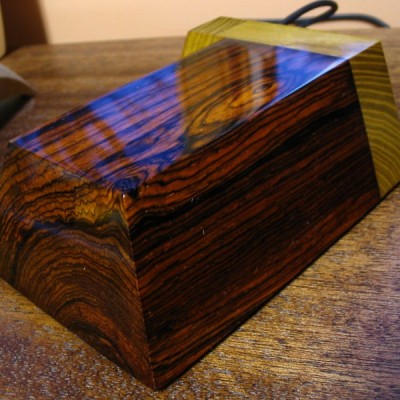
Can you see the end-grain?
Manufactured wood such as MDF, OSB, and particleboard all have a distinct look that is—in nearly all cases—easily distinguishable from the endgrain of real wood. Look for growth rings—formed by the yearly growth of a tree—which will be a dead-giveaway that the wood sample in question is a solid, genuine chunk of wood taken from a tree.
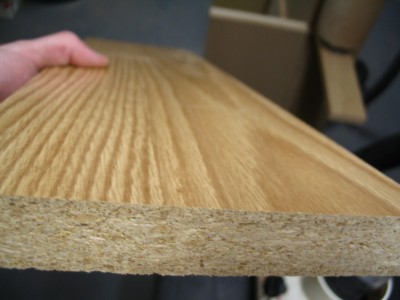
Is it veneered?
If you see a large panel that has a repeating grain pattern, it may be a veneer. In such cases, a very thin layer of real wood is peeled from a tree and attached to a substrate; sometimes the veneer can be one continuous repeating piece because it is rotary-sliced to shave off the veneer layer as the tree trunk is spun by machines. Assuming it is a real wood veneer with a distinct grain and texture—and not merely a piece of printed plastic—you may still be able to identify the outer veneer wood in question, but you should still realize that is it only a veneer and not a solid piece of wood.
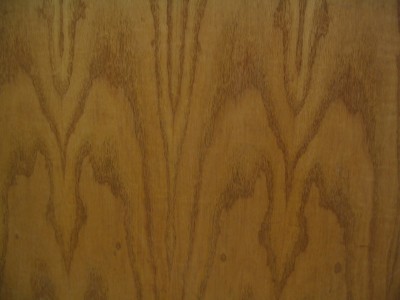
Is it painted or printed to look like wood?
Many times, especially on medium to large-sized flat panels for furniture, a piece of particleboard or MDF is either laminated with a piece of wood-colored plastic, or simply painted to look like wood grain. Many of today’s interior hardwood flooring planks are good examples of these pseudo-wood products: they are essentially a man-made material made of sawdust, glues, resins, and durable plastics.
2. Look at the color.
Some questions to immediately ask yourself:
Is the color of the wood natural, or is it stained?
If there is even a chance that the color isn’t natural, the odds are increased that the entire effort of identifying the wood will be in vain.
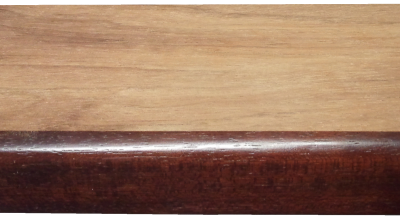
Is it weathered or have a patina?
Many woods, when left outside in the elements, tend to turn a bland gray color. Also, even interior wood also takes on a patina as it ages: some woods get darker, or redder, and some even get lighter or lose their color; but for the most part, wood tends to darken with age.
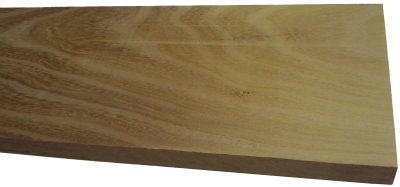
Is it possible to sand or plane the board to see the natural raw color of the wood?
The most predictable baseline to use when identifying wood is in a freshly sanded state. This eliminates the chances of a stain or natural aging skewing the color diagnosis of the wood.
3. Observe the wood grain.
If the wood is unfinished, then look at the texture of the grain. Ask yourself these questions:
Does the wood have an open, porous texture?
Most softwoods will be almost perfectly smooth with no grain indentations, while many common hardwoods have an open pore structure, such as oak or mahogany; though there are some hardwoods that are also smooth to the touch, such as maple.
Can you tell if the wood is quartersawn or plainsawn?
By observing the grain patterns, many times you can tell how the board was cut from the tree. Some wood species have dramatically different grain patterns from plainsawn to quartersawn surfaces. For instance, on their quartersawn surfaces, lacewood has large lace patterns, oak has flecks, and maple has the characteristic “butcher block” appearance.
Is there any figure or unusual characteristics, such as sapwood, curly or wild grain, burl/knots, etc.?
Some species of wood have figure that is much more common than in other species: for example, curly figure is fairly common in soft maple, and the curls are usually well-pronounced and close together. Yet when birch or cherry has a curly grain, it is more often much less pronounced, and the curls are spaced farther apart.
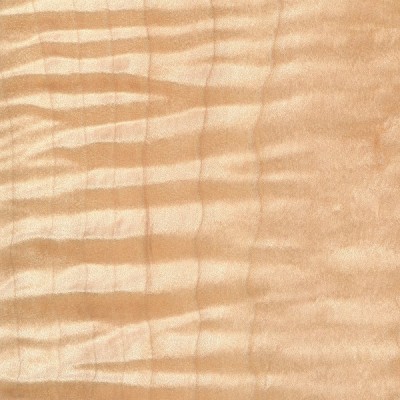
4. Consider the weight and hardness of the wood.
If it’s possible, pick the piece of wood up and get a sense of its weight, and compare it to other known wood species. Try gouging the edge with your fingernail to get a sense of its hardness. If you have a scale, you can take measurements of the length, width, and thickness of the wood, and combine them to find the density of the wood. This can be helpful to compare to other density readings found in the database. When examining the wood in question, compare it to other known wood species, and ask yourself these questions:
Is the wood dry?
Wood from freshly felled trees, or wood that has been stored in an extremely humid environment will have very high moisture contents. In some freshly sawn pieces, moisture could account for over half of the wood’s total weight! Likewise, wood that has been stored in extremely dry conditions of less than 25% relative humidity will most likely feel lighter than average.
How does the wood’s weight compare to other species?
Taking into account the size of the board, how does its weight compare to other benchmark woods? Is it heavier than oak? Is it lighter than pine? Look at the weight numbers for a few wood species that are close to yours, and get a ballpark estimate of its weight.
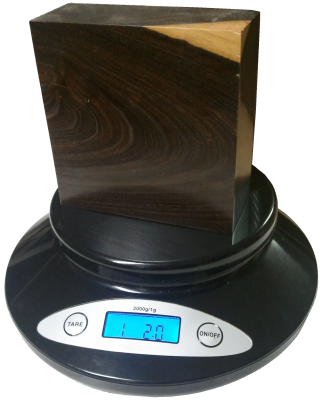
How hard is the wood?
Obviously softwoods will tend to be softer than hardwoods, but try to get a sense of how it compares to other known woods. Density and hardness are closely related, so if the wood is heavy, it will most likely be hard too. If the wood is a part of a finished item that you can’t adequately weigh, you might be able to test the hardness by gouging it in an inconspicuous area. Also, if it is used in a piece of furniture, such as a tabletop, a general idea of its hardness can be assessed by the number and depth of the gouges/dings in the piece given its age and use. A tabletop made of pine will have much deeper dents than a tabletop made of Oak. Additionally, you can always try the “fingernail test” as a rough hardness indicator: find a crisp edge of the wood, and with your fingernail try to push in as hard as you can and see if you’re able to make a dent in the wood.
5. Consider its history.
Many times we forget common sense and logic when attempting to identify wood. If you’ve got a piece of Amish furniture from Pennsylvania, chances are more likely that the wood will be made of something like black walnut or cherry, and not African wenge or jatoba. You might call it “wood profiling,” but sometimes it can pay to be a little prejudiced when it comes to wood identification. Some common-sense questions to ask yourself when trying to identify a piece of wood:
Where did it come from?
Knowing as much as you can about the source of the wood—even the smallest details—can be helpful. If the wood came from a wood pile or a lumber mill where all the pieces were from trees processed locally, then the potential species are immediately limited. If the wood came from a builder of antique furniture, or a boat-builder, or a trim carpenter: each of these occupations will tend to use certain species of woods much more often than others, making a logical guess much simpler.
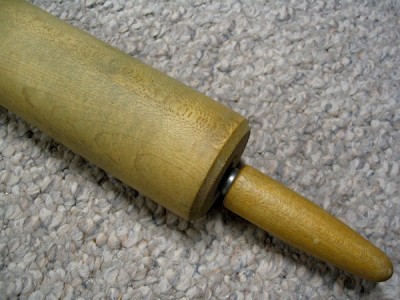
How old is it?
As with the wood’s source, its age will also help in identification purposes. Not only will it help to determine if the wood should have developed a natural patina, but it will also suggest certain species which were more prevalent at different times in history. For instance, many acoustic guitars made before the 1990s have featured Brazilian rosewood backs/sides, yet due to CITES restrictions placed upon that species, East Indian rosewood became a much more common species on newer guitars. (And this is a continuing shift as newer replacements are sought for rosewoods altogether.)
How large is the piece of wood?
Some species of trees are typically very small—some are even considered shrubs—while others get quite large. For instance, if you see a large panel or section of wood that’s entirely black, chances are it’s either painted, dyed, or stained: Gaboon ebony and related species are typically very small and very expensive.
What is the wood’s intended use?
Simply knowing what the wood was intended for—when considered in conjunction with where it came from and how old it is—can give you many clues to help identify it. In some applications, certain wood species are used much more frequently than others, so that you can make an educated guess as to the species of the wood based upon the application where it was used. For instance, in the United States: many older houses with solid hardwood floors have commonly used either red oak or hard maple; many antique furniture pieces have featured quartersawn white oak; many violins have spruce tops; many closet items used aromatic red cedar, and so forth. While it’s not a 100% guarantee, “profiling” the wood in question will help reduce the number of possible suspects, and aid in deducing the correct species.
6. Find the X-Factor.
Sometimes, after all the normal characteristics of a sample have been considered, the identity of the wood in question is still not apparent. In these instances—particularly in situations where a sample has been narrowed down to only a few possible remaining choices—it’s sometimes helpful to bring in specialized tests and other narrower means of identification.
The following techniques and recommendations don’t necessarily have a wide application in initially sorting out wood species and eliminating large swaths of wood species, but will most likely be of use only as a final step in special identification circumstances.
Odor
Believe it or not, freshly machined wood can have a very identifiable scent. When your eyes and hands can’t quite get a definitive answer, sometimes your nose can. Assuming there is no stain, finish, or preservative on or in the wood, quickly sand, saw, or otherwise machine a section of the wood in question, and take a whiff of the aroma.
Although new scents can be very difficult to express in words, many times the scent of an unknown wood may be similar to other known scents. For instance, rosewoods (Dalbergia spp.) are so named for their characteristic odor that is reminiscent of roses. Although difficult to directly communicate, with enough firsthand experience scents can become a memorable and powerful means of wood identification.
Fluorescence
While certain woods can appear basically identical to one another under normal lighting conditions, when exposed to certain wavelengths—such as those found in blacklights—the wood will absorb and emit light in a different (visible) wavelength. This phenomenon is known as fluorescence, and certain woods can be distinguished by the presence or absence of their fluorescent qualities. See the article Fluorescence: A Secret Weapon in Wood Identification for more information.
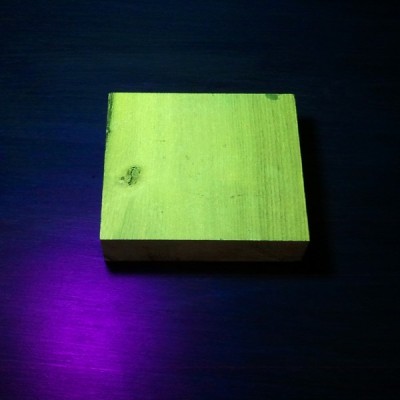
Chemical Testing
There are only a small number of chemical tests regularly used on wood, most of which are very specialized and were developed to help distinguish easily confused species with one another. They work by detecting differences in the composition of heartwood extractives. A chemical substance (called a reagent) is usually dissolved in water and applied to the wood surface: the surface is then observed for any type of chemical reaction (and accompanying color change) that may occur. Two of the most useful are the tests that are meant to separate Red and White Oak, and Red and Hard Maple.
Heartwood Extractives Leachability
Sometimes a wood species will have heartwood extractives that will be readily leachable in water and capable of conspicuously tinting a solution of water a specific color. For instance, the heartwood extractives contained in osage orange (Maclura pomifera) contain a yellowish-brown dye that is soluble in water. (This can sometimes be observed anecdotally when the wood is glued with a water-based adhesive: the glue’s squeeze-out is an unusually vibrant yellow.)
In a simple water extract color test, wood shavings are mixed with water in a vial, test tube, or other suitably small container, and the color of the water is observed after a few minutes. If the heartwood extractives are leachable by water, then a corresponding color change should quickly occur.
In addition to osage orange (Maclura pomifera), merbau (Intsia spp.), and rengas (Gluta spp. and Melanorrhoea spp.) are also noted for their readily leachable heartwood extractives. Because this property is quite uncommon, it can serve to quickly differentiate these woods from other lookalikes.
7. Look at the endgrain.
Perhaps no other technique for accurate identification of wood is as helpful and conclusive as the magnified examination of the endgrain. Frequently, it brings the identification process from a mostly intuitive, unscientific process into a predictable, repeatable, and reliable procedure.
Looking at the endgrain with a magnifier shouldn’t be a mystifying or esoteric art. In many cases, it’s nearly as simple as examining small newsprint under a magnifying glass. There are three components necessary to reap the full benefits contained in the endgrain:
I. A prepared surface.
When working with wood in most capacities, it becomes quickly apparent that endgrain surfaces are not nearly as cooperative or as easily worked as face grain surfaces. However, in this case, it is absolutely critical that a clear and refined endgrain surface is obtained.
For a quick glance of a softwood sample, a very sharp knife or razor blade can be used to take a fresh slice from the endgrain. However, in many denser species, especially in tropical hardwoods, one of the best ways to obtain a clear endgrain view is through diligent sanding. It’s usually best to begin with a relatively smooth saw cut (as from a fine-toothed miter saw blade) and proceed through the grits, starting at around 100, and working up to at least 220 or 320 grit, preferably higher for the cleanest view.
II. The right magnifier.
It need not be expensive, but whatever tool is used to view the endgrain should have adequate magnifying power. In most instances, 10x magnification is ideal, however, anything within the range of 8 to 15x magnification should be suitable for endgrain viewing. (Standard magnifying glasses are typically in the range of 2 to 4x magnification.)
These stronger magnifiers, sometimes called loupes, usually have a smaller viewing area than standard magnifying glasses. Fancier models—with built in lights, or larger viewing surfaces—are available at a premium; but the most basic models are usually only a few dollars.
III. A trained eye.
The third element that constitutes a proper endgrain examination is simply knowing what to look for. In analyzing the patterns, colors, shapes, and spacing of the various anatomical features, there is a veritable storehouse of information within the endgrain—all waiting to be unlocked. Yet, if these elements have not been pointed out and learned, the array of features will simply seem like an unintelligible jumble. The discipline of recognizing anatomical endgrain features is not easily summed up in a few sentences or even a few paragraphs, but it is nonetheless critical to the identification process. To this end, an in-depth look should be given to the various categories, divisions, and elements that constitute endgrain wood identification on the macroscopic level. (In this regard, macroscopic denotes what can be seen with a low-powered, 10x hand lens—without the aid of a microscope—rather than simply what can be seen with the naked eye.) Because the anatomy between softwoods and hardwoods is so divergent, each will be considered and examined separately:Still stumped?
If you have a mysterious piece of wood that you’d like identified, you’ve got a few options for next steps:USDA’s Forest Products Laboratory
You can mail your physical wood samples to the Center for Wood Anatomy Research.
Pros:
- Free
- Professional wood identification
Cons:
- Only available to US citizens
- Slow turnaround times (up to a month or more)
- Limited to three IDs per year
See their Wood ID Factsheet for more info.
Alden Identification Service
You can mail your physical wood samples (even small sections taken from antiques) to Alden Identification Service.
Pros:
- Professional wood identification
- Faster turnaround times (ranging from a few days to a week or two)
Cons:
- Paid service
See their ordering page for more info. (Note that Harry Alden has written several books while at USDA, including both Hardwoods and Softwoods of North America.)
Ask for help online
If the wood ID is merely a curiosity, or non-critical, you can post pictures of the wood in question.
Pros:
- Free
- No need to send physical samples
Cons:
- Greatly limited by the quality of the pictures provided
- Extra work usually required to get adequate clarity in photos
See article of Common US Hardwoods to help find the most commonly used woods.
Get the hard copy
 If you’re interested in getting all that makes The Wood Database unique distilled into a single, real-world resource, there’s the book that’s based on the website—the Amazon.com best-seller, WOOD! Identifying and Using Hundreds of Woods Worldwide. It contains many of the most popular articles found on this website, as well as hundreds of wood profiles—laid out with the same clarity and convenience of the website—packaged in a shop-friendly hardcover book.
If you’re interested in getting all that makes The Wood Database unique distilled into a single, real-world resource, there’s the book that’s based on the website—the Amazon.com best-seller, WOOD! Identifying and Using Hundreds of Woods Worldwide. It contains many of the most popular articles found on this website, as well as hundreds of wood profiles—laid out with the same clarity and convenience of the website—packaged in a shop-friendly hardcover book. 


Why I will no longer be replying to every wood ID request I’ve replied to literally thousands of wood ID requests on this site over the past 13+ years, but as the site’s popularity has grown, so has the time demands for ID on a daily basis. (Contrary to what some may seem to think, I am not some all-knowing wood wizard that can instantly ID your wood. It can actually take me a long time to sift through a lot of different resources.) Over the past few years, my backlog of pending wood species to be added to the… Read more »
I have tongue in groove hardwood flooring I am trying to identify, in my home, circa 1930’s, in Montreal, Canada. Boards are stamped “perfection made in Canada”. I’m guessing Birch, but not sure. Some areas I uncovered (under the ceramic, plywood and vinyl over layers!! Horrors!! ) are damaged, so I would like to identify the species so I can replace just those sections, then sand it all down and stain anew. The boards are 2. 25″ generally in width, and 3/3″ thick. Finish is very worn out in some areas, more warm in others. Can u tell what wood… Read more »
Yes, it looks like either maple or birch. Generally, you’ll see more ray fleck in maple, but it’s sometimes hard to tell. From your pics, I’d be more inclined to say birch.
Hi Eric and Others I have an antique table (circa 1850s) for which I am trying to determine the wood type. Photos sent to antique dealers yielded suggestions of Australian (Red) Cedar and “Rosewood” without further clarification of the latter. The same dealers suggested the table origin to be Australian or English. From your site information, I think I can rule out the Red Cedar. There is no exposed raw endgrain, but the table feet do show some of the pore, ray and parenchyma characteristics your site references, albeit under a finished surface. I cannot detect any particular smell. I… Read more »
That last picture is a surprisingly good view of the endgrain. It does look like a true rosewood to me. This is based on the banded parenchyma, as well as the large, infrequent pores. Based on its age and appearance, there’s a chance it could be Brazilian rosewood. I’d say it may be worth taking to an appraiser in person for a better look.
I was given a small piece of wood by some men who were guarding a Harpy Eagle nest in eastern Venezuela. The little block is very hard and heavy, like a rosewood. It is a maroon-purple color. It is definitely not purpleheart. It has extremely fine grain. I recently turned a pen blank from it and finished it with CA glue. The wood has no discernible odor. I am familiar with most tropical hardwoods available on the international market and this block resembles none of them that I know. I have attached photos. Any help would be appreciated.
Can you try attaching pics again, they didn’t come through.
I found your site while trying to identify the wood in this Victorian era nursing rocking chair. With your guidance, I’ve decided it is white oak ( because having read several pages I am now an expert, right? ;) ) Have I identified it correctly? Circa 1880s, mostly pegged with two imperfect screws and many little apholstery nails and tacks. Very light weight chair but the wood is tough as nails.
I don’t know if the weight is age or the small size and quantity in use. The chair is very low and I guesstimate the weight at under 20pounds.
Sorry, I can’t make out enough details of the wood grain in those pictures. The last picture I can see it is a ring porous (or semi-ring porous) hardwood, but not enough detail to ID it as oak. The cross piece looks different and may be made of a different wood type.
I do hardwood flooring patches and a customer sent me these pictures. The wood looks to me like Leopard / Lacewood, except the indentation from moving this furniture is so deep, it may be something similar but softer. Appreciate any insights!
Possibly sycamore (Platanus spp.), though some species of lacewood are rather soft. Silky oak is another possibility.
Any idea what kind of wood it is made off? It is coming from my grand mother .
Found in my yard in southwest Missouri, I sanded it down to 220 grit, it isn’t stained or anything.
I can see the colors of the stripes are different but are they the same wood? Pictures are of end grain and edge grain. Thanks!
Hi – Thanks for the great work! Any idea what wood this frame is? 19th Century veneer out of England. Looks kind of between mahogany and maple in color (but that may just be the French polish, and grain doesn’t look like either). Thanks!
Recently refinished this dresser, stripped the mahogany stain off..it’s definitely red. If anyone could help me identify this wood it would be greatly appreciated! thank you. need to order this book!
Possibly a type of mahogany.
Hi, Im trying to make perches for my parrot. I found this branch outside in the bushes near some trees but I need to know what type of wood it is in order to see if its toxic to my bird. The branch feels really dry but I thank thats because its quite old. (I found it a year ago and i kept it in the house since then). It seems like it has white pores. I actually used sandpaper to smooth out the surface (not a lot tho). It has a woody smell to it by the way but… Read more »
I bought this cutting board however it didn’t say anywhere what wood it is made out of. I oiled it so it looks shiny and slighly darker than normally. It was made in Thailand and cost me £25.
That’s probably rubberwood.
I bought this small bookcase recently and I’m not sure what type of wood it’s made of.
I can’t tell for sure as the endgrain is too rough to make out clear details, but tentatively I can say it resembles mahogany.
Moved to Sweden from America and after befriending an old woodworker He gave me this piece of wood. I planed it down and I still don’t know forsure what kind of wood it is. Would love to get an answer from an experienced carpenter! The first picture is it beside a piece of walnut. The second picture is the end grain before cutting it. The third is side of the piece. It looks like African Mahogany but I’m not sure.
I agree it looks like a type of mahogany. Can you by chance get a shot of the grain *after* you’ve cut it? Or, something that’s clearer/sanded? You might also want to take a look at this article: https://www.wood-database.com/wood-articles/mahogany-mixups-the-lowdown/
What an excellent article! I loved this. Thank you.
This is a Dark Red Meranti
This is the top of my grandmother’s library table that I’m currently refinishing. It was stained with a very dark stain about 35 years ago. I know she had it for my whole life, and I’m 45. I don’t know how long she had it before that. I’ve sanded with 60, 80, and 120 so far. I would love to know what type of wood it is.
It looks like a series of nearly perfectly quartersawn boards of black walnut to me.
Thanks so much for your response. I had a vague memory from childhood that had me stubbornly convinced that it was exactly that, so I appreciate your input. (You should see some of the tooling marks – I’m doing my best to preserve them as I go.)
Hi, I have an unfinished door that I plan to stain and want to consider the type of wood that it is. Are you able to tell with this couple of pictures? Thanks so much!
That’s a softwood of some sort. Regardless of species, it will be a little tougher to stain, so you’ll want to look for something like a gel-type stain or something that can stain softwoods with creating blotches.
Thanks so much, Eric. Sounds like I should definitely use pre-stain wood conditioner before staining, as well. Will do. Thx again for your time!
Judy
Does anyone know what kind of wood this is or how much it would go for?
Can’t tell wood type, but if that is a true inlay of mother of pearl or something similar/genuine, it’s probably worth getting it professionally appraised.
I bought this wood from a woodturners workshop after he passed away. I thought it was white oak through the dirt but it is not. It has a smell of poop when cutting. The long straight picture shows the end grain and the square picture shows the side grain.
That looks like a species of hard pine. I can see the resin canals in the endgrain, so there’s only a relatively narrow column of potential softwoods that it could be. I’m not sure what softwoods would be commonly use in Ireland, but that would be a very good place to start.
Bought this bathroom vanity made by Pegasus secondhand. I’ve found very little information online about the company. I plan on making a matching wood frame for the bathroom mirror but need to know the type of wood. I polyurethaned the wood when I bought it. It seems like it’s a soft and lightweight wood but it’s hard to tell. If you have any ideas what kind of wood it is please let me know. Thanks
Yes, looks like a softwood. That straight grain is from quartersawn lumber, so if you were going to try to match it, you’d want to find pieces that are quartersawn rather than flatsawn. Probably something like pine or douglas fir.
What wood is this? I believe it’s at least 40 years old purchased in Greenwood, Mississippi.
I want to get new cabinet doors and drawer fronts/boxes and I need to know the type of wood pattern this is, please help?
Looks like a ring porous hardwood. The pattern is just standard grain when flatsawn, though sometimes called cathedral grain. I think oak or ash would be a good source to yield this sort of pattern.
Thank you!!
Can anyone help with this?
No replies yet, but I think it’s birch… anyone else?
Hi there! Looking for help to ID the wood of our 40+ year old deck. It is in amazing condition overall but has many layers of peeling paint. They are 2×6 boards and many are full 15′ pieces. After a few days exposed to air, you’ll see some colouring changes in photo looking reddish. A pleasant smell but not very distinct. Thanks!
Looks to be in very good condition for 40 years old, especially since I can still see sapwood on some pieces. A softwood species, I’d guess a type of pine.
Thanks so much! We are new owners but the neighbours tell us it’s that old – it’s possible they are forgetting a refresh. Learning we need to be cautious as we refinish since it is likely treated with CCA esp if it is pine. Luckily no reactions so far but we are going to be more cautious as we finish the rest.
This was a drawer front planed down to remove the finish looks like maybe walnut. Please help.
Doesn’t look like walnut to me. It looks like a diffuse porous tropical hardwood, possibly mahogany.
That is either Sapele or Honduran Mahogany. Definitely from the Mahogany family.
It was used as the structural frame for a house that was over 100 years old in Kansas. It used square nails. Some of the cuts stay really stringy and rough
Is it possible to get a cleaner/sanded view of the endgrain? It’s hard to make out details on the endgrain surface as-is.
Let’s see if they attached
I don’t see anything new.
Trying again
If this doesn’t work I will start a new thread
Thanks, that came through. Looks like oak.
Thank you so much! I know it is absolutely gorgeous when burnt and costed with a spar urethane. Glad I didn’t use it to frame in an old sliding glass door like I bought it for ?. I probably have 1000 lbs of this lumber that I paid $50 for sight unseen. Lucky me!
When we sanded the clear coat the places that the stain came off were a light colored wood.
Greetings! I wonder if anyone can help me to identify this wood type, which was used to build a frame for me for a large art piece? I’d be eternally grateful :)
Thank you!
Power washed. Still has some stain present around knots. Not sure what kind of wood
Wood does have a distinctive smell
Help
whatis this wood?
Looks like oak to me, though it looks a bit unusual, I’m not sure why the colors are so varied across these boards.
Was someone testing Polyurethane on some boards but not others? Some look pink and some look yellowish.
I live in a timber frame, listed house. The timber is oak, painted black and then painted oak colour. The actual wood is therefore concealed. I’ve had a dendrochronologist bore 13 beams and confirm oak and date 1648. In the kitchen is a beam with multiple coats of white paint. A specialist who should know what he is on about scratched off a tiny area of paint and said it is pine. This week I’ve stripped the paint (at least five layers and a horrible job!) and I’m down to the wood with original saw marks. To me this looks… Read more »
Well, I hate to say it, but that looks like a softwood (such as pine) to me. You can tell at the point of the darker growth rings. Oak is a ring porous wood, so the darker growth rings would be open and porous, since it is composed of more or less hollow tubes (called vessels by wood anatomists). In softwoods like pine, the growth rings are actually composed of solid fibers that are slightly denser than the surrounding wood, which appears to be what you have in the pictures.
That’s an answer, many thanks. Some major work was done on the house in about 1820 and, as the beam is softwood, I guess it was brought in then to replace a damaged beam. I’m told Scotch Pine was being imported into England from Norway about this time. The beam supports and has been jointed to a confirmed 1648 oak beam, so it must have been quite a job to get it in.
Hi Eric,
Thanks for any help. I was noticing today that there are pieces of quartersawn mixed in with my red oak victorian flooring. They have big, pronounced medulary rays. However, the trim in the house has much thinner medullary rays (if that’s what they are) that run kind of east-west. Is it still quarter sawn red oak, or could it be a different wood or cut? Any ideas?
The coloring looks sort of like curly maple, maybe? It’s fairly light, so I don’t think it’s white oak.
It may not be a natural wood color, so you may not be able to use that as a basis of ID. It’s not curly maple, as the figure in your pics is ray fleck and not curly grain pattern.
Thanks. It seems to exhibit Chatoyance much more than the quarter sawn oak I’ve seen, whatever it is.
Only think I can think of that would look like that in your local area would be quartersawn sycamore. That’s assuming it is a domestic timber.
That definitely could be it, thanks!
Sir,
relying on your knowledge would you guide me how to examine a Himalyan cedar deodar wood. As it appears almost the same to Himalayan kail(Pine) wood.is there any specific method to distinguish between these two types of wood?
For softwoods, it’s very important to look at a clear, sanded view of the endgrain. You need to check for resin canals: https://www.wood-database.com/wood-articles/softwood-anatomy/#resin_canals
Species of pine will have resin canals, while they will be lacking in cedars.
Hi, I was hoping to get a rough guesstimate of what type of wood this box is made from.
Thank you!
Looks like a dense softwood (such as southern yellow pine) that’s been stained a darker color.
Thank you!
My husband is a hobbyist woodturner and was given a log from a friend’s tree that they had taken down. They had no idea what type of tree it was. The tree was in Ohio. He turned it onto this beautiful bowl. Can you help the type of wood.
Thanks!
Looks like burl wood of some sort. Possibly maple burl.
Hello can you please tell me if it’s cumaru or ipe?
I have a side board and would like to know what wood it is made from>
Looks like a ring porous hardwood. Possibly oak.
I have Antique English Inlaid Desk in 1860-1870, made of rosewood.
I would like to know whether this is Brazilian Rosewood or not for overseas moving.
I wonder if you could tell which rosewood this is?
Endgrain in photo is about 12-14mm (7/16″ -9/16″ )
Thank you.
I can’t tell conclusively from the pictures. But the parencyhma patterns do suggest a genuine Dalbergia rosewood, and the sparseness of the pores would at least have an increased likelihood of being Brazilian rosewood. But either way, I think you’d have a very difficult time moving this piece internationally. In the past few years, all rosewoods have come under CITES protection (at least, pieces exceeding 10 kilograms, which is meant to specifically exclude musical instruments but include pieces of furniture).
Thank you very much for the detailed information.
trying again with hopefully pictures that will open larger? As per earlier post, baseboard wood from 1980’s(?) used in home in Alberta Canada. Thought initially might be Hemlock(?) but that’s just a guess. Tight grain pattern, moderately light, no identifiable odor when sawn. thanks, Rick
Sorry, the picture are still the same size. Also, can you get a picture of the finished face on the other side of the wood?
apologies for the pictures not coming through clearly. I may have to find a 10 yr old somewhere to help this old guy!
Trying to attach 2 new, hopefully larger, photos. First shows underside of 2 pieces of molding (left & centre). On the right side of photo is finished surface. 2nd photo is also a finished side, but with an end cut. Thanks again,
Looks like mahogany to me.
thank you, much appreciated
Can anyone help me identify the wood species on this door from 1904?
Hard to tell from that distance, but if it really is as heavy as you say it is, then I would say maple is most likely candidate. Otherwise, if it’s softer, it could be a species of softwood. I know western white pine (Pinus monticola) would’ve been a common wood in your region.
Hi, I recently got given this lump of timber and having some trouble identifying it. Narrowed it down to possible Jarrah/Cumaru/Camelthorn but struggling to get any clarity
Piece is old and feels very dry and comes in with an SG around 1.1 and smells like feet when milled
Please reattach pics, as they didn’t come through. Also, please tell us your geographic region — even if you don’t know where the wood came from exactly. Different woods are much more common (even imported wood selection) in different areas.
Hi there! I’m trying to sell a beautiful antique wooden table and I couldn’t quite figure out what type of wood it is made from. Could you help with the attached photographs?
Thanks very much
Hi, Would anyone have any good ideas what wood this handle is? The photo is quite a solid representation. It feels fairly light. Thanks
Just to add i believe the geographic location of the wood to be Pakistan (currently reads UK) ^^^
We are trying to find out what type of wood this is, and about how old it is. My husband was told that this table is from the civil war era. Im not so sure, though. Any idea?
On the underside of the table top there is writing or a stamp, that I can’t tell what is says. That is in the last picture.
Thank you for your help.
It looks like a veneered top of quartersawn white oak. This cut and species is very popular in antiques. I don’t know much about determining age based on the style of furniture, but I’d guess that it more than likely at least pre-dates WWII, but I think you’d need a professional appraiser to get a more accurate estimation.
I’ new to this and hope I’m doing it right, if not my apologies. Many years ago I worked and lived in Alaska. 40+ years ago I left and before I left loaded a conex with my possessions and 2 other items, they were abandon water tanks. I disassembled them marking all pieces and then they set these last 40 years. Today with the price of wood gone nuts I ran one them through a jointer to see what it looked like. The following is the best information I know about this wood and would appreciate any help ID’ing for… Read more »
Thanks Gene, pictures would help. Please try to reattached them because they didn’t come through. (Also, try to reply within this thread instead of starting a new comment so it will appear connected to your comment.)
Thanks Eric, new to this.
Last one,
Also on the smell the new cut is actually very aromatic and reminds me of something, but what I can’t remember.
I don’t know if this helps but… Coming from Alaska with history 80 years plus I though it may be native to the area, so spruce. Does spruce have an aromatic smell, like this does, when cut?, I don’t know. Then looked at pictures of spruce wood and they look similar. Researched the use of spruce in aircraft and the requirements for spars state that at least 6-8 rings per inch is a requirement. With this I measured my piece and spruce goes out as a candidate since this has 20 rings per inch which is 2.5 times that number.… Read more »
Spruce wouldn’t have any kind of a scent. Would the scent, by chance, be similar to raw potatoes? It might be yellow cedar. See the page here: https://www.wood-database.com/alaskan-yellow-cedar/
Eric, I think you hit a home run… When you gave me the clue “raw potatoes” the neurons aligned to what I was smelling. I think you are right. Having lasted all these years and from research on what water tanks were made from, i.e. Cypress and AYC is also called the same and its origin Alaska AYC makes sense. So I’m going with AYC. Good job, well don… thank you. The smell kind of reminded me of cedar but not quite and besides it was not what I knew, color wise, as cedar. Much denser than cedar. Now that… Read more »
So why my interest after 40 years of having this mystery wood? Good question. My friend and neighbor has cancer, will pass soon and is under hospice care at home. I wanted something that belong to him and bought his jointer, not knowing exactly what its purpose was. It belong to my friend. So watching and reading I fired it up remembered and skinned a piece of this old forgotten wood of 40 years ago. I think its beautiful and needs a new purpose. Maybe some book shelves. Further reading I’m leaning somewhat away from spruce if what I’ve read… Read more »
I would appreciate it if anyone can identify the wood in this walking stick.
I have found this beautiful old wooden table lamp at a market in the UK. I am just trying to work out what wood it is made of. It so heavy, and has a beautiful grain. I thought it maybe Elm but not sure. Any ideas? thank you
What kind of wood is this?
Sorry on the location, it was salvaged from a broken pallet so it could be international. I reckoned it to be rough sawn spalted Maple but once sanded and the piece on the left with a light coat of oil, I don’t know. It does smell like an old Maple….but the figure has me baffled. Thank you in advance.
I wonder if someone can identify the wood in this coffee table, my partner wants to get a similar dining table but this was made by a local guy who made furniture as a hobby – sadly now passed so (obviously) not able to check. Any thoughts gratefully appreciated. NB: Can’t be sure about the weight, I’m fairly sure the legs are made of something different.
Looks like Myrtle to me. Pull up some web pics of myrtle burl and it is very similar. Just a guess.
Looks like either burr elm or english pippy oak. Google both and see what you think
I have 5 planks of very light-colored wood which is also light weight. They are about 2′ true x 14″ true x 10 ‘. My late father told me it was Basswood but how can I tell for sure. There are a few very thin, dark grains, like almost black and the width of a thin sharpie.